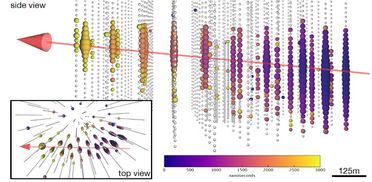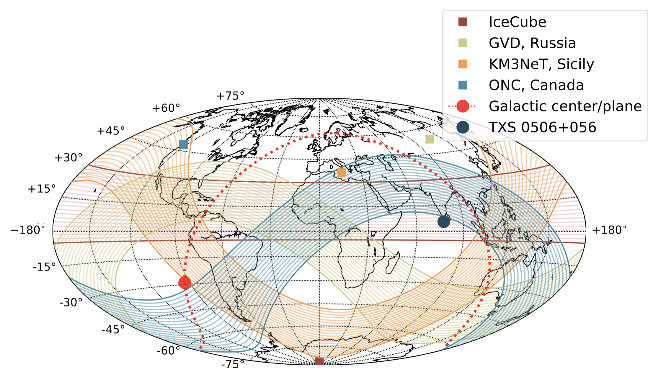P-ONE: Why we need another neutrino telescope
Neutrinos are the key to exploring the high-energy universe. The neutral elementary particles are generated in cataclystic cosmic events and travel cosmological distances undeflected and unhindered. But detecting one of these elusive high-energy particles is a challenge: it requires a cubic-kilometer sized detector instrumented with thousands of light sensors that is installed in a deep-sea or deep-ice environment.
Where are the high-energy neutrinos coming from?

In 2013, IceCube Neutrino Observatory at the South Pole was the first neutrino telescope to discover high-energy astrophysical neutrinos. In 2018, astrophysicists found the first compelling evidence for an association of high-energy neutrinos and a known blazar with the catalogue number TXS0506+06. But out of the more than one hundred highest-energy cosmic neutrinos detected by IceCube only a few could have been associated with an astrophysical source. So where are they coming from?
As observed by IceCube, these highest-energy neutrinos come from all over the sky, therefore, most of them need to be of extragalactic origin although a galactic origin cannot entirely be excluded. Various sources have been proposed: blazars, star-forming galaxies, the outflows of active galactic neucleis (AGNs), gamma ray bursts, galaxy clusters as well as high-energy galactic sources. To reconstruct the origin of a neutrino, the muon-neutrino is favoured among the three neutrino types because at energies of PeV to TeV, the muon-neutrino interaction with matter produces a track-like pattern of Cherenkov light that very precisely is aligned with the direction of origin of the incoming neutrino.
Why a telescope's observable horizon is limited
But a single high-energy neutrino telescope is not feasible to cover the entire sky: First of all, to identify the track-like signature correctly as produced by an astrophysical neutrino and to separate it from atmospheric neutrinos, only tracks that are going upwards are considered, using the Earth as a filter (alternatively, a part of the telescope's volume is employed as a veto). Secondly, since the cross section of neutrinos increases with increasing energy, the Earth almost gets opaque to neutrinos with energies above 50 TeV: at around 100 TeV, less than 20% of the neutrinos with next-to vertical direction can cross the Earth; at 1 PeV the rate reduces to 5%. Neutrino telescopes are therefore effectively blind to high-energy neutrinos crossing the Earth. Combining these two constraints implies that high-energy neutrinos of astrophysical origin are only observable at around 20 - 30 degrees of the telesope's horizon.

P-ONE & how to cover the entire sky
These neutrino detections and the first association with a cosmic source demonstrate that the field of astroparticle physics is currently at the beginning of a new era. At present, a global effort is underway to explore the sky at the highest energies in order to reveal the most powerful cosmic accelerators. The contributing parties are the neutrino telescopes ANTARES (12 strings) in operation since 2008, KM3NeT under construction in the Mediterranean, the Gigaton Volume Detector (GVD) under construction at Lake Baikal, Russia, IceCube-Gen2 at the South Pole, and the new initiative Pacific Ocean Neutrino Explorer (P-ONE) to be installed within the Ocean Networks Canada (ONC) infrastructure in the Pacific.
If they were combined and used as a single distributed planetary instrument (that we call the high-energy Planetary Neutrino Monitoring System (PLEnUM)), it would cover almost the entire sky and the detection probability would improve by up to two orders of magnitude with respect to the one IceCube has today.
